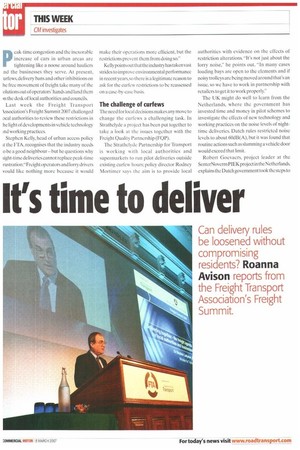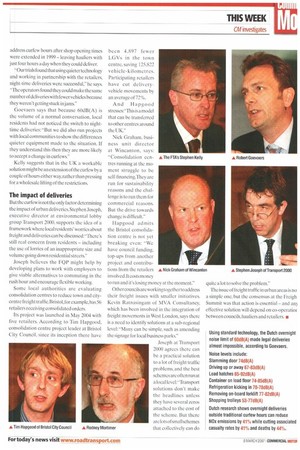It's time to deliver
Page 26

Page 27

If you've noticed an error in this article please click here to report it so we can fix it.
peak-time congestion and the inexorable increase of cars in urban areas are tightening like a noose around hauliers .nd the businesses they serve. At present, urfews, delivery bans and other inhibitions on he free movement of freight take many of the olutions out of operators' hands and land them m the desk of local authorities and councils.
Last week the Freight Transport kssociation's Freight Summit 2007 challenged ocal authorities to review these restrictions in he light of developments in vehicle technology Ind working practices.
Stephen Kelly, head of urban access policy it the ETA, recognises that the industry needs o be a good neighbour— but he questions why light-time deliveries cannot replace peak-time rustration:"Freight operators and lorry drivers vould like nothing more because it would make their operations more efficient, but the restrictions prevent them from doing so."
Kelly points out that the industry has taken vast strides to improve environmental performance in recent years, so there is a legitimate reason to ask for the curfew restrictions to be reassessed on a case-by-case basis.
The challenge of curfews
The need for local decisions makes any move to change the curfews a challenging task. In Strathclyde a project has been put together to take a look at the issues together with the Freight Quality Partnership (FOP).
The Strathclyde Partnership for Transport is working with local authorities and supermarkets to run pilot deliveries outside existing curfew hours; policy director Rodney Mortimer says the aim is to provide local authorities with evidence on the effects of restriction alterations. "It's not just about the lorry noise," he points out. "In many cases loading bays are open to the elements and if noisy trolleys are being moved around that's an issue, so we have to work in partnership with retailers to get it to work properly.
The UK might do well to learn from the Netherlands, where the government has invested time and money in pilot schemes to investigate the effects of new technology and working practices on the noise levels of nighttime deliveries. Dutch rules restricted noise levels to about 60dB(A), but it was found that routine actions such as slamming a vehicle door would exceed that limit.
Robert Goevaers, project leader at the SenterNoverrnPIEK project inthe Netherlands, explains the Dutch government took the steps to address curfew hours after shop opening times were extended in 1999— leaving hauliers with just four hours a day when they could deliver.
"Our trials found that using quieter technology and working in partnership with the retailers, night-time deliveries were successful," he says. "'the operators found they could make the same number of deliveries with fewer vehicles because they weren't getting stuck in jams."
Goevaers says that because 60dB( A ) is the volume of a normal conversation, local residents had not noticed the switch to nighttime deliveries: "But we did also run projects with local communities to show the differences quieter equipment made to the situation. If they understand this then they are more likely to accept a change in curfews."
Kelly suggests that in the UK a workable solution might be an extension of the curfew by a couple of hours either way, rather than pressing for a wholesale lifting of the restrictions.
The impact of deliveries
I301 the curfew is not the only factor determining the impact of urban deliveries. Stephen Joseph, executive director at environmental lobby group Transport 2000, supports the idea of a framework where local residents' worries about freight and deliveries can be discussed:—Ibere's still real concern from residents — including the use of lorries of an inappropriate size and volume going down residential streets."
Joseph believes the FQP might help by developing plans to work with employers to give viable alternatives to commuting in the rush hour and encourage flexible working.
Some local authorities are evaluating consolidation centres to reduce town and citycentre freight traffic.Bristokfor example,has 56 retailers receiving consolidated orders.
Its project was launched in May 2004 with five retailers. According to Tim Hapgood, consolidation centre project leader at Bristol City Council, since its inception there have been 4,897 fewer LGVs in the town centre, saving 125,822 vehicle-kilometres. Participating retailers have cut deliveryvehicle movements by an average of 72%.
And Hapgood stresses:"Thisis a model that can be transferred to other centres around the UK."
Nick Graham. business unit director at Wincanton, says: "Consolidation cenA The FTA's Stephen Kelly tres running at the moment struggle to be self-financing.They are run for sustain ability reasons and the challenge is to run them for commercial reasons. But the drive towards change is difficult."
Hapgood admits the Bristol consolidation centre is not yet breaking even: -We have council funding, top-ups from another project and contributions from the retailers involved, It costs money to run and it's losing money at the moment."
Othercouncilsare working together toaddress their freight issues with smaller initiatives. Kevin Ratnasingam of M VA Consultancy, which has been involved in the integration of freight movements in West London, says there is a need to identify solutions at a sub-regional level: "Many can be simple, such as amending the signage for local business parks." A Nick Graham of Wincanton Joseph at Transport 2000 agrees there can be a practical solution to a lot of freight traffic problems, and the best schemes are often run at a local level:"Transport solutions don't make the headlines unless they have several zeros attached to the cost of the scheme. But there are lots of small schemes that collectively can do quite a lot to solve the problem."
The issue of freight traffic in urban areas is no a simple one, but the consensus at the FreighSummit was that action is essential — and an) effective solution will depend on co-operatior between councils, hauliers and retailers. •
Using standard technology, the Dutch overnight noise limit of 60d8(A) made legal deliveries almost impossible, according to Goevaers.
Noise levels include: Slamming door 74dB(A) Driving up or away 67-83dB(A) Load hatches 65-92dB{A) Container on load floor 74-85dB(A) Refrigeration kicking in 70-78dB(A) Removing on-board forklift 77-82dB(A) Shopping trolleys 53-77dB(A) Dutch research shows overnight deliveries outside traditional curfew hours can reduce NOx emissions by 41% while cutting associated casualty rates by 41% and deaths by 44%.






















































































































































































